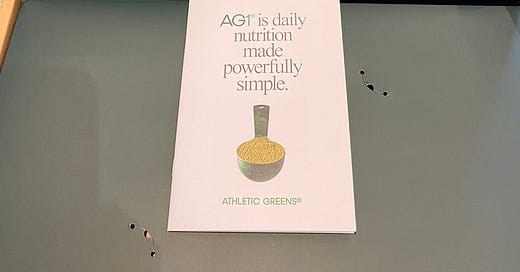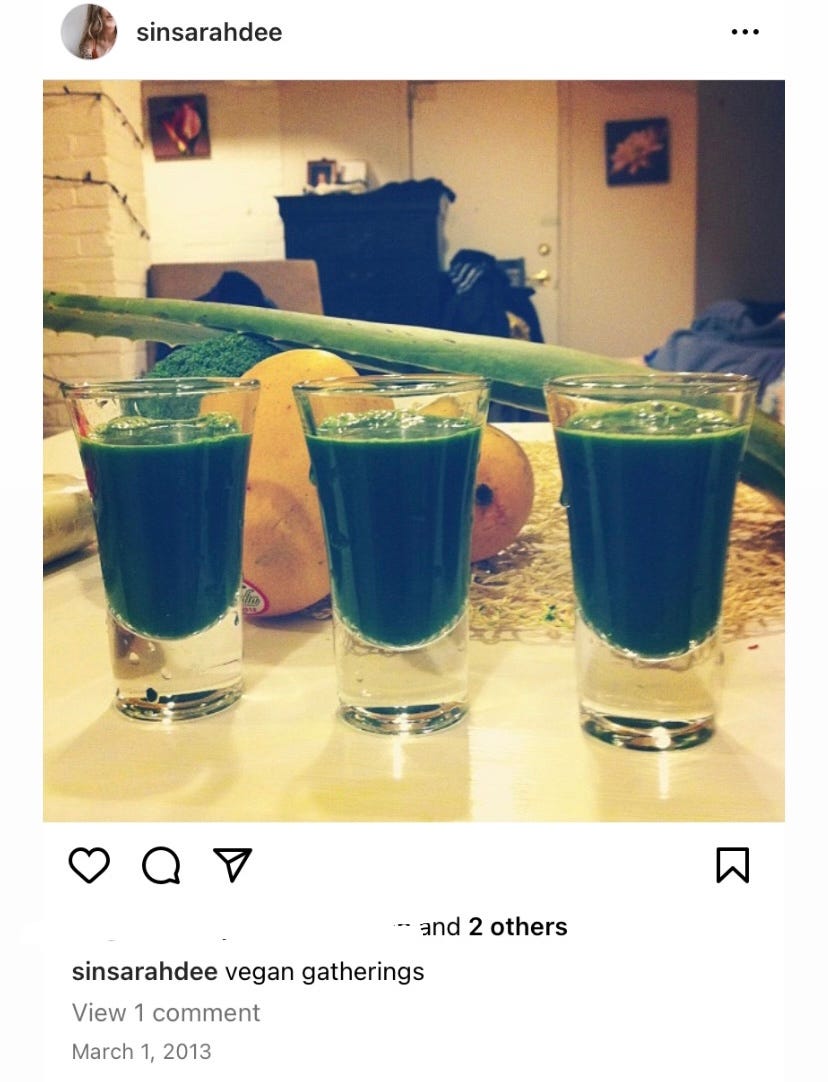i tried athletic greens so you didn't have to
and it tastes more like wellness culture than pineapple
In the world of wellness and fitness, beverages have the power to publicly speak more to one’s lifestyle than nearly any other exercise or dietary regimen, particularly in a visual and aesthetic-focused online culture. Many identity-defining beverages follow the basic logic of liquids in to replace liquids lost through exercises and became highly popularized in the early aughts through the two-prong force of Gatorade/Powerade ads between basketball games, and the VitaminWater built-in ads during Gossip Girl. The act of simply carrying around a drink could showcase your interest in stayed hydrated, being sporty, or your allegiance to Jenny Humphrey.
Since then, wellness-driven beverages have swerved into a form of elitist bat-signal, with influencers and their coffin nails steadily clutching onto their metal straws while touting the benefits of their mysterious powder-based substances across social media. Newer iterations of in-crowd beverages have gone green, and unlike the sweaty electrolyte predecessors, it is not always clear what purpose or value drinks like Athletic Greens have, or what cultural values they speak to an era where glamorous, “old money” lifestyles are on full (albeit quiet) display.
But is Athletic Greens worth the hype it gets?
drink your greens
Green juices and elixirs are far from a new fad. The amount of juice cleanse information I had to hold (or perhaps more accurately, fake) while working at a vegan smoothie bar and restaurant in the 2010s has been a permanent reminder of that for me. I would be forcefully asked by severely-tanned white women named Venus with bleach blonde hair and tiny diamonds in their noses whether the Urban Detox (a greens-heavy cold pressed juice with strong notes of chard and cayenne) would be better to use on a five day juice-only diet than the Immune Boost (a sweeter cold pressed juice with carrots and beets and a name that made everyone think it would fix them). I’d tell customers about how each was a different blend of vitalizing, energizing, immunizing, destabilizing, or any other “izing” adjective I could think of on the fly at 11:35 am on a Wednesday.
Cold pressed juices, celery-based drinks, and other green juices have held the attention of the health and wellness-obsessed elites for some time. Even those of us at home in the 2010s were interested in seeing how we could take the $50 worth of grocery store greens we bought and turn it into a sharp and bitter green shot (see my own 2013 rendition below - though keep in mind, these juices were the collective efforts of 3 lifeguard pay cheques at the time).
The wellness beverage world has shifted towards niche areas of the body, ones where problems haven’t been invented yet, such as the gut and the microbiome. If wellness brands have to feign ethics for a more ethically-conscious consumer, mentioning visible body parts becomes much trickier (when was the last time you saw a brand outright mentioning it would fix your cellulite?). When body neutrality and positivity have become entrenched in public personas of major celebrities and social discourse, it is harder to profit off of body shame tactics of the past.
Wellness brands got better at finding more nondescript ways of maintaining the body as a problem, offering to fix us with increasingly expensive and complicated chemistries. Wellness beverages (that is, beverages with vague or loose claims to enhance once’s sense of wellness and health), have pivoted their formulae to align with the more perennial and intimate concerns (bloat, satiation, “cleansing” the body). And in this field, no product has gotten more internet hype or campaigning than Athletic Greens, or AG1.
AG1 has pushed the bar for the wellness beverage advertisement higher and higher. And by higher, I mean that it has pushed wellness greens past the point of believability into an upper echelon of wealth and privilege. It’s touched on what it really means to be healthy, or how one is able to maintain optimized healthiness while we continue to pick up the pandemic pieces and navigate the wreckage of our health care systems, our understandings of wellbeing, and our overall ability to function in daily society.
Through the Instagram and TikTok ad campaigns of lifestyle and wellness influencers, AG1 has drenched its presence as the wellness beverage of the decade. Much of its appeal has been wrapped in the glossiness of these micro-celebrity lifestyles. It is difficult to find accounts of people trying it and accurately speaking to its qualities, namely due to the upfront cost of purchasing the powder. Those who do usually drink it without sponsorship are of the same influencer stratum where they stand a chance to one day get a sponsorship (and thus do not want to risk the relationship).
I was curious for many reasons about the grip that AG1 has had on social media, and the veil of wellness folklore being cast upon it through it’s built-in class boundaries. I wanted to unpack the experience in a more personal trial and error-style way. While I’m going to explore how AG1 fits into these broader spaces of wellness, I also felt that the only way to speak to it fairly is to also try the substance and see if it really worked or was a modern snake oil – er, snake powder.
So, I tried it for 30 days in the hopes that you won’t have to.
get your AG1
I had first heard about Athletic Greens through a podcasting ad campaign roll call. These ad campaigns are pitched to podcasters in the hopes that some of us reach out with the right audience, topic scope, and ability to convey a message about a wellness product in a convincing and natural way – an ad that doesn’t feel like an ad, because it’s sent to you by your trusted podcasters straight into the intimacy of your eardrums.
While I am near certain my podcast collective either doesn’t enjoy me or doesn’t know how to feel about me, I had previously created a bit of sponsored content for a specific type of wellness honey (and before it was even on the Kardashian’s radar, a point of weird for me). There have been a lot of internal feelings about slinging wellness products in order to pay for hosting the podcast on Libsyn – particularly my own disdain for the wellness industrial complex. But it sits within the constant navigation I had in my twenties of how to make money for a show that doesn’t make money, when I was also making very little money as a grad student, and how to do it in a way that could feel somewhat aligned with my internal values.
By the time I received the AG1 campaign email, I was less interested in making influencer money (imagine? With my monotone?) and more intrigued as a researcher. I’m a big gym nerd on my personal social media page and have brought bits of that into my podcast social media as well.
I thought the idea of having a sports drink campaign could be fun and easy, until I was met with the booking criteria:
Ad format: Host read (dynamic/embedded)
Audience Criteria: 25-54 women (high-income audiences), Modern Mom, Self Care enthusiasts, Traveling Mom, Busy Mom, Health Focused
On a good day, I’d maybe fit into two of those audience criteria categories personally (Busy Mom, and Health Focused) – but even then, it would be a stretch given that I am health focused in the “let’s examine Western health systems and alternative medicine systems and why there’s such an important relationship between our bodies and minds in the post-Industrial age” not Almond Mom-drinking-skinny-margarita way.
Nothing about these greens felt like a good fit with my own identity, but that made me all the more inclined to explore the idea. The campaign call itself was so clearly focused on reaching wealthy, modern mothers above all else. What do those mothers possess that us scrappy millennial mothers that hustle between 3-4 contract jobs don’t? Beyond money, at least.
the trial
A few months after I saw the call for influencers in my inbox, I saw the campaign roll out in full force with all the influencers and health and fitness junkies with large, wealthy followings slurping back this deep green sludge with sheer joy. One of the lines that caught my attention was just how many of them would wince (even subtly), and then smile to say, “mm, there’s a hint of pineapple in there!”
Brands you’ve booked a campaign for will usually send a few notes on what the product is about, and the key points to make when pitching it (but organically, in your own words– it’s your experience!). If you manage to incorporate their key phrases effortlessly, and attract a certain number of sales linked to your customized discount code, you’ll be re-hired for the next ad campaign usually.
There was one Canadian beauty YouTuber that I’ve followed for a while who had taken to drinking AG1 despite not actually being sponsored by them. I normally enjoy her YouTube and Instagram stories simply because she’s really funny, but also in the echelon the brand wanted to use to sell powder. Surprisingly, she was the only one who let the half wince upon first seaweed green gulp melt into the full squished face of someone who absolutely despises what they’re being made to drink, joking that “this tastes like shit. This just… tastes like shit. But maybe it won’t if I’m sponsored?” at one point.
That had settled my internal interest, for the sake of science (and for the sake of being exhausted by wellness industry). I purchased it online, and after accounting for the Canadian currency exchange it was about $120 for me to have my one-month trial subscription. That included the baggie of green powder, a very sturdy feeling green metal scoop, a plastic shaker bottle with a metal lid and the AG1 logo plastered all over it, a free travel pack of AG1 powder, a liquid vitamin D supplement, and a green metal canister to store my baggie of greens so it looks more aesthetic on my shelf (which, I will note, is covered with very un-aesthetic protein powders and supplements).
I steadfastly took notes on every detail of the box the AG1 kit was sent in, the messaging in all the thick paper information pamphlets that accompanied it, and the details on how to best enjoy your AG1 greens. It immediately became quite overwhelming.
tastes like wellness
Across TikTok and Instagram, a lot of non-sponsored takes on AG1 were quick to reveal they despised the taste of AG1. I am not sure if it’s because of the promise of sweet, pure and simple greeny-greens to digest and help release all the toxins of the world from your body, but there is a strong adverse reaction to the taste and texture of the drink.
In my own experience, it just tastes exactly as what you would expect a health foods store drink to taste like (if you tried anything from the 90s to mid-2000s in a local health foods store run by a Mennonite or a Seventh Day Adventist or a born-again Christian, I am sure you know what I mean). It tastes earthy, chalky, sludgy, and has a sweet little after-taste, which is what I’d imagine is that “hint” of pineapple or vanilla. I wouldn’t say it’s god awful, but it is ripe with metaphor.
As Maggie Lange writes for The Cut,
“What Athletic Greens oozes is a type of holistic easiness... Athletic Greens seems more natural, “cleaner,” the color of “real food.” And while the vitamins and probiotics doubtlessly surge through the drink, working untold magic on the interior, the external signal of Athletic Greens also provides a potent appeal to investors and consumers alike.”
The actual health benefits of AG1 have been largely unconfirmed about its specific formula’s effectiveness.
During my own nutritional education in university, my instructors showcased the difficulty of isolating any one vitamin or mineral to assess its impact on the body, let alone how it interacts with multiple different probiotics, prebiotics, vitamins and minerals. While each of the 75 ingredients within AG1 may have health benefits in their own rights, making any sturdy claims about how the drink benefits your nutrition and health directly are lofty at best.
There have been no specific clinical trials about the AG1 formula itself, so assumptions around its benefits are based on a breakdown of its many ingredients. However, with other green powders being on the market for decades, a more general early picture of their potential benefits and uses as blended-vitamin conduit for the body has come into focus. Some research spanning from 2004 to now has documented a few considerations:
Anti-oxidative properties (Rao et al., 2011): A four-week study of plant-based supplement greens found significant reduction in protein and fat oxidation (though this was only with 10 participants over a month)
Blood pressure (Zhang et al., 2009): A 90-day study of 40 participants from a chiropractic college faculty and student population found that those with high blood pressure taking a daily greens powder had decreased both systolic and diastolic blood pressure by around 8%, and the control group – not having high blood pressure – had no observed improvement.
Energy changes (Boon et al., 2004): A 12-week trial found significantly improved energy in a study of 105 women (double blind, placebo-controlled clinical trial) who took green supplements (Greens+) during the study period (though Greens+ does also contain a green tea extract, so caffeine’s interaction should also be considered).
Immunity: Greens powders are typically high in vitamin A and C, which help to support immune function, and probiotic-focused greens may also help to support immune function as well as digestive health, but brand-specific studies or supplement formula-specific studies are hard to track down, or are funded directly from the product manufacturers which increases risk of a biased read of the results.
While many of the studies around green powder supplement use support that there are benefits to using them, it tends to be vary based on which ingredients are present in the formula, and the benefits seem to be fairly limited in these early and small pilot studies.
My approach has always been that of balance – plants are good for you in any way you can get them, so long as they are affordable for you.
less science, more lifestyle
What AG1 does well is marketing a health-focused lifestyle in the socially conscious 2020s. We’re emerging from a deadly pandemic, we’re keen to get back into the swing of life, and how better to do it than to reach for the most “real,” the most “pure,” and the most green things we can in the hopes that osmosis will eventually cure us of all our modern ails.
Industries and governments are continuing their press tour of climate change as individual’s fault (rather than industry) despite record-breaking global temperatures and the lack of evidence that industrial carbon-offsets work near as well as cutting emissions entirely. In this vein, it makes sense that greenwashing the body has become more prominent, much like we greenwashed our homes in response to early 2000s carbon offset campaigns. The problem with purity though, is that it is also infused with the more millennial desire to streamline and optimize experiences to be edgeless.
Charlotte Parlour, a beauty-line founder, regularly discusses skincare, makeup, and millennial mentalities on her social media pages. She discusses the millennial ability to optimize life in ways previous generations could not.
 Tiktok failed to load.
Tiktok failed to load.Enable 3rd party cookies or use another browser
What is sometimes seen as lazy, for example, is really understood for millennials to mean a way of working where you pay reduced costs for transportation and can balance life with a bit more ease. It doesn’t make it glamorous, but it does create an experience that is more tailored to individual needs and budgets .
For me, AG1 seems to be an extension of this optimization trend amongst more well-off millennials. Similar to Soylent (a protein nutrition meal replacement shake that was adored by tech bros in the 2010s), AG1 provides you with every imaginable vitamin and mineral and probiotic your body could want, rather than taking the time in the morning to scoop out three tablespoons of mango-flavoured fish oil, one vitamin D chewable, two raspberry-flavoured probiotics, a cranberry pill, two turmeric gummies, and so on. Instead, you could grab one scoop of sea-foam green powder, plop it in your convenient shaker, and be done with it for the day.
Where it loses me is less about the optimization of health, and more where the advocation for a purist lifestyle comes in. After purchased AG1, I started to get emails and social media messaging around having AG1 on an empty stomach, or after having a water with lemon, and then received more targeted ads about supplements to help you develop better gut bacteria. These constant reminders and pressures to make my gut healthy got to me mentally within the first two weeks of trying it out. (And the reality is, these drinks and supplements just make you poop more regularly).
my AG1 verdict
The ability to powder up greens and have them on the run is beneficial for busy days, or for periods where you may be under more physical and mental stress, potentially not up for cooking meals or seeking out multiple supplements the way you normally might. AG1 leverages this, and expects that you could drink AG1 every single day in perpetuity, until perhaps one day you became a spirulina robot of health to add to their “hint of pineapple” army.
Through experience, I am keenly aware of the granular line between wellness and disordered eating, and the more I heard about improving these micro-ecosystems in my body for overall alignment, the more I started to get shaky about drinking it. It felt as though I had to drink it every single day, and if I didn’t, I wasn’t athletic, I wasn’t healthy, and I wasn’t optimizing my body.
And that is exactly where the problem lies for me.









Interesting read! Thank you for testing it and breaking it down. Seems like overall it can be a good backup, but leave it at that (at least for my potential use case).